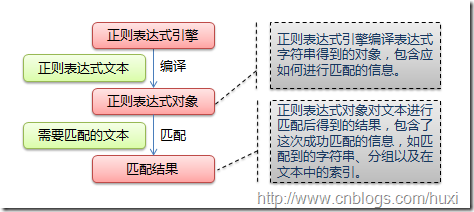正則表達式並不是Python的一部分。正則表達式是用於處理字元串的強大工具,擁有自己獨特的語法以及一個獨立的處理引擎,效率上可能不如str自帶的方法,但功能十分強大。得益於這一點,在提供了正則表達式的語言里,正則表達式的語法都是一樣的,區別隻在於不同的編程語言實現支持的語法數量不同;但不用擔心,不被
1. 正則表達式基礎
1.1. 簡單介紹
正則表達式並不是Python的一部分。正則表達式是用於處理字元串的強大工具,擁有自己獨特的語法以及一個獨立的處理引擎,效率上可能不如str自帶的方法,但功能十分強大。得益於這一點,在提供了正則表達式的語言里,正則表達式的語法都是一樣的,區別隻在於不同的編程語言實現支持的語法數量不同;但不用擔心,不被支持的語法通常是不常用的部分。如果已經在其他語言里使用過正則表達式,只需要簡單看一看就可以上手了。
下圖展示了使用正則表達式進行匹配的流程: 
正則表達式的大致匹配過程是:依次拿出表達式和文本中的字元比較,如果每一個字元都能匹配,則匹配成功;一旦有匹配不成功的字元則匹配失敗。如果表達式中有量詞或邊界,這個過程會稍微有一些不同,但也是很好理解的,看下圖中的示例以及自己多使用幾次就能明白。
下圖列出了Python支持的正則表達式元字元和語法: 
1.2. 數量詞的貪婪模式與非貪婪模式
正則表達式通常用於在文本中查找匹配的字元串。Python里數量詞預設是貪婪的(在少數語言里也可能是預設非貪婪),總是嘗試匹配儘可能多的字元;非貪婪的則相反,總是嘗試匹配儘可能少的字元。例如:正則表達式"ab*"如果用於查找"abbbc",將找到"abbb"。而如果使用非貪婪的數量詞"ab*?",將找到"a"。
1.3. 反斜杠的困擾
與大多數編程語言相同,正則表達式里使用"\"作為轉義字元,這就可能造成反斜杠困擾。假如你需要匹配文本中的字元"\",那麼使用編程語言表示的正則表達式里將需要4個反斜杠"\\\\":前兩個和後兩個分別用於在編程語言里轉義成反斜杠,轉換成兩個反斜杠後再在正則表達式里轉義成一個反斜杠。Python里的原生字元串很好地解決了這個問題,這個例子中的正則表達式可以使用r"\\"表示。同樣,匹配一個數字的"\\d"可以寫成r"\d"。有了原生字元串,你再也不用擔心是不是漏寫了反斜杠,寫出來的表達式也更直觀。
1.4. 匹配模式
正則表達式提供了一些可用的匹配模式,比如忽略大小寫、多行匹配等,這部分內容將在Pattern類的工廠方法re.compile(pattern[, flags])中一起介紹。
2. re模塊
2.1. 開始使用re
Python通過re模塊提供對正則表達式的支持。使用re的一般步驟是先將正則表達式的字元串形式編譯為Pattern實例,然後使用Pattern實例處理文本並獲得匹配結果(一個Match實例),最後使用Match實例獲得信息,進行其他的操作。
| 1 2 3 4 5 6 7 8 9 10 11 12 13 14 15 |
# encoding: UTF-8
import re
# 將正則表達式編譯成Pattern對象
pattern = re.compile(r'hello')
# 使用Pattern匹配文本,獲得匹配結果,無法匹配時將返回None
match = pattern.match('hello world!')
if match:
# 使用Match獲得分組信息
print match.group()
### 輸出 ###
# hello
|
re.compile(strPattern[, flag]):
這個方法是Pattern類的工廠方法,用於將字元串形式的正則表達式編譯為Pattern對象。 第二個參數flag是匹配模式,取值可以使用按位或運算符'|'表示同時生效,比如re.I | re.M。另外,你也可以在regex字元串中指定模式,比如re.compile('pattern', re.I | re.M)與re.compile('(?im)pattern')是等價的。
可選值有:
- re.I(re.IGNORECASE): 忽略大小寫(括弧內是完整寫法,下同)
- M(MULTILINE): 多行模式,改變'^'和'$'的行為(參見上圖)
- S(DOTALL): 點任意匹配模式,改變'.'的行為
- L(LOCALE): 使預定字元類 \w \W \b \B \s \S 取決於當前區域設定
- U(UNICODE): 使預定字元類 \w \W \b \B \s \S \d \D 取決於unicode定義的字元屬性
- X(VERBOSE): 詳細模式。這個模式下正則表達式可以是多行,忽略空白字元,並可以加入註釋。以下兩個正則表達式是等價的:
| 1 2 3 4 |
a = re.compile(r"""\d + # the integral part
\. # the decimal point
\d * # some fractional digits""", re.X)
b = re.compile(r"\d+\.\d*")
|
re提供了眾多模塊方法用於完成正則表達式的功能。這些方法可以使用Pattern實例的相應方法替代,唯一的好處是少寫一行re.compile()代碼,但同時也無法復用編譯後的Pattern對象。這些方法將在Pattern類的實例方法部分一起介紹。如上面這個例子可以簡寫為:
| 1 2 |
m = re.match(r'hello', 'hello world!')
print m.group()
|
re模塊還提供了一個方法escape(string),用於將string中的正則表達式元字元如*/+/?等之前加上轉義符再返回,在需要大量匹配元字元時有那麼一點用。
2.2. Match
Match對象是一次匹配的結果,包含了很多關於此次匹配的信息,可以使用Match提供的可讀屬性或方法來獲取這些信息。
屬性:
- string: 匹配時使用的文本。
- re: 匹配時使用的Pattern對象。
- pos: 文本中正則表達式開始搜索的索引。值與Pattern.match()和Pattern.seach()方法的同名參數相同。
- endpos: 文本中正則表達式結束搜索的索引。值與Pattern.match()和Pattern.seach()方法的同名參數相同。
- lastindex: 最後一個被捕獲的分組在文本中的索引。如果沒有被捕獲的分組,將為None。
- lastgroup: 最後一個被捕獲的分組的別名。如果這個分組沒有別名或者沒有被捕獲的分組,將為None。
方法:
- group([group1, …]):
獲得一個或多個分組截獲的字元串;指定多個參數時將以元組形式返回。group1可以使用編號也可以使用別名;編號0代表整個匹配的子串;不填寫參數時,返回group(0);沒有截獲字元串的組返回None;截獲了多次的組返回最後一次截獲的子串。 - groups([default]):
以元組形式返回全部分組截獲的字元串。相當於調用group(1,2,…last)。default表示沒有截獲字元串的組以這個值替代,預設為None。 - groupdict([default]):
返回以有別名的組的別名為鍵、以該組截獲的子串為值的字典,沒有別名的組不包含在內。default含義同上。 - start([group]):
返回指定的組截獲的子串在string中的起始索引(子串第一個字元的索引)。group預設值為0。 - end([group]):
返回指定的組截獲的子串在string中的結束索引(子串最後一個字元的索引+1)。group預設值為0。 - span([group]):
返回(start(group), end(group))。 - expand(template):
將匹配到的分組代入template中然後返回。template中可以使用\id或\g<id>、\g<name>引用分組,但不能使用編號0。\id與\g<id>是等價的;但\10將被認為是第10個分組,如果你想表達\1之後是字元'0',只能使用\g<1>0。
| 1 2 3 4 5 6 7 8 9 10 11 12 13 14 15 16 17 18 19 20 21 22 23 24 25 26 27 28 29 30 31 32 |
import re
m = re.match(r'(\w+) (\w+)(?P<sign>.*)', 'hello world!')
print "m.string:", m.string
print "m.re:", m.re
print "m.pos:", m.pos
print "m.endpos:", m.endpos
print "m.lastindex:", m.lastindex
print "m.lastgroup:", m.lastgroup
print "m.group(1,2):", m.group(1, 2)
print "m.groups():", m.groups()
print "m.groupdict():", m.groupdict()
print "m.start(2):", m.start(2)
print "m.end(2):", m.end(2)
print "m.span(2):", m.span(2)
print r"m.expand(r'\2 \1\3'):", m.expand(r'\2 \1\3')
### output ###
# m.string: hello world!
# m.re: <_sre.SRE_Pattern object at 0x016E1A38>
# m.pos: 0
# m.endpos: 12
# m.lastindex: 3
# m.lastgroup: sign
# m.group(1,2): ('hello', 'world')
# m.groups(): ('hello', 'world', '!')
# m.groupdict(): {'sign': '!'}
# m.start(2): 6
# m.end(2): 11
# m.span(2): (6, 11)
# m.expand(r'\2 \1\3'): world hello!
|
2.3. Pattern
Pattern對象是一個編譯好的正則表達式,通過Pattern提供的一系列方法可以對文本進行匹配查找。
Pattern不能直接實例化,必須使用re.compile()進行構造。
Pattern提供了幾個可讀屬性用於獲取表達式的相關信息:
- pattern: 編譯時用的表達式字元串。
- flags: 編譯時用的匹配模式。數字形式。
- groups: 表達式中分組的數量。
- groupindex: 以表達式中有別名的組的別名為鍵、以該組對應的編號為值的字典,沒有別名的組不包含在內。
| 1 2 3 4 5 6 7 8 9 10 11 12 13 |
import re
p = re.compile(r'(\w+) (\w+)(?P<sign>.*)', re.DOTALL)
print "p.pattern:", p.pattern
print "p.flags:", p.flags
print "p.groups:", p.groups
print "p.groupindex:", p.groupindex
### output ###
# p.pattern: (\w+) (\w+)(?P<sign>.*)
# p.flags: 16
# p.groups: 3
# p.groupindex: {'sign': 3}
|
實例方法[ | re模塊方法]:
- match(string[, pos[, endpos]]) | re.match(pattern, string[, flags]):
這個方法將從string的pos下標處起嘗試匹配pattern;如果pattern結束時仍可匹配,則返回一個Match對象;如果匹配過程中pattern無法匹配,或者匹配未結束就已到達endpos,則返回None。
pos和endpos的預設值分別為0和len(string);re.match()無法指定這兩個參數,參數flags用於編譯pattern時指定匹配模式。
註意:這個方法並不是完全匹配。當pattern結束時若string還有剩餘字元,仍然視為成功。想要完全匹配,可以在表達式末尾加上邊界匹配符'$'。
示例參見2.1小節。 - search(string[, pos[, endpos]]) | re.search(pattern, string[, flags]):
這個方法用於查找字元串中可以匹配成功的子串。從string的pos下標處起嘗試匹配pattern,如果pattern結束時仍可匹配,則返回一個Match對象;若無法匹配,則將pos加1後重新嘗試匹配;直到pos=endpos時仍無法匹配則返回None。
pos和endpos的預設值分別為0和len(string));re.search()無法指定這兩個參數,參數flags用於編譯pattern時指定匹配模式。
1 2 3 4 5 6 7 8 9 10 11 12 13 14 15 16 # encoding: UTF-8importre# 將正則表達式編譯成Pattern對象pattern=re.compile(r'world')# 使用search()查找匹配的子串,不存在能匹配的子串時將返回None# 這個例子中使用match()無法成功匹配match=pattern.search('hello world!')ifmatch:# 使用Match獲得分組信息printmatch.group()### 輸出 #### world - split(string[, maxsplit]) | re.split(pattern, string[, maxsplit]):
按照能夠匹配的子串將string分割後返回列表。maxsplit用於指定最大分割次數,不指定將全部分割。
1 2 3 4 5 6 7 importrep=re.compile(r'\d+')printp.split('one1two2three3four4')### output #### ['one', 'two', 'three', 'four', ''] - findall(string[, pos[, endpos]]) | re.findall(pattern, string[, flags]):
搜索string,以列表形式返回全部能匹配的子串。
1 2 3 4 5 6 7 importrep=re.compile(r'\d+')printp.findall('one1two2three3four4')### output #### ['1', '2', '3', '4'] - finditer(string[, pos[, endpos]]) | re.finditer(pattern, string[, flags]):
搜索string,返回一個順序訪問每一個匹配結果(Match對象)的迭代器。
1 2 3 4 5 6 7 8 importrep=re.compile(r'\d+')forminp.finditer('one1two2three3four4'):printm.group(),### output #### 1 2 3 4 - sub(repl, string[, count]) | re.sub(pattern, repl, string[, count]):
使用repl替換string中每一個匹配的子串後返回替換後的字元串。
當repl是一個字元串時,可以使用\id或\g<id>、\g<name>引用分組,但不能使用編號0。
當repl是一個方法時,這個方法應當只接受一個參數(Match對象),並返回一個字元串用於替換(返回的字元串中不能再引用分組)。
count用於指定最多替換次數,不指定時全部替換。
1 2 3 4 5 6 7 8 9 10 11 12 13 14 15 importrep=re.compile(r'(\w+) (\w+)')s='i say, hello world!'printp.sub(r'\2 \1', s)deffunc(m):returnm.group(1).title()+' '+m.group(2).title()printp.sub(func, s)### output #### say i, world hello!# I Say, Hello World! - subn(repl, string[, count]) |re.sub(pattern, repl, string[, count]):
返回 (sub(repl, string[, count]), 替換次數)。
1 2 3 4 5 6 7 8 9 10 11 12 13 14 15 importrep=re.compile(r'(\w+) (\w+)')s='i say, hello world!'printp.subn(r'\2 \1', s)deffunc(m):returnm.group(1).title()+' '+m.group(2).title()printp.subn(func, s)### output #### ('say i, world hello!', 2)# ('I Say, Hello World!', 2)
以上就是Python對於正則表達式的支持。熟練掌握正則表達式是每一個程式員必須具備的技能,這年頭沒有不與字元串打交道的程式了。筆者也處於初級階段,與君共勉,^_^
另外,圖中的特殊構造部分沒有舉出例子,用到這些的正則表達式是具有一定難度的。有興趣可以思考一下,如何匹配不是以abc開頭的單詞,^_^



